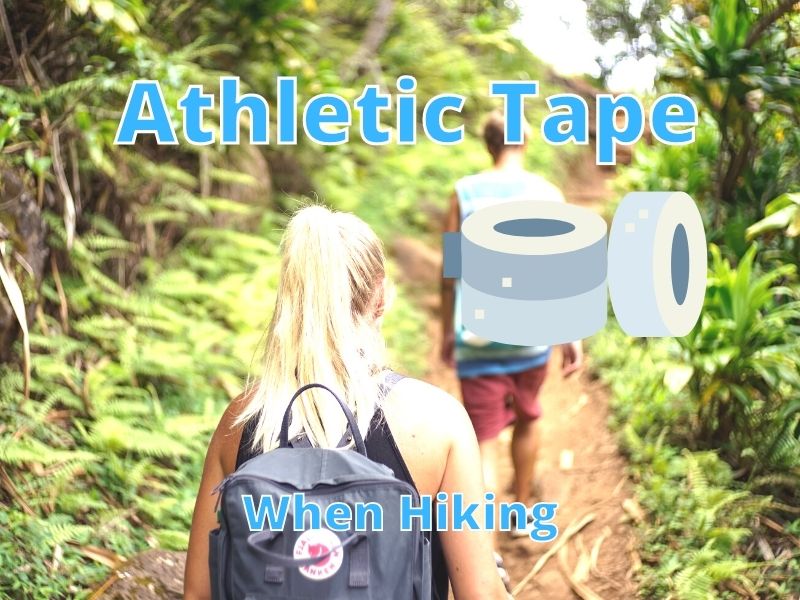It can be annoying to go on a hike and have your shoes start to rub on your feet and start to cause blisters or sensitive areas. When I’ve used tape to cover sensitive areas, I’ve always had a good experience with the tape protecting my feet.
Athletic tape can help protect your feet while you are hiking all day. It can provide effective all-day protection and support when applied correctly. Athletic tape is strong, sticky, and provides good protection for blisters and support for sprains.
Various kinds of tape have different attributes: stretchy or tight, breathable or less so, and easy to peel off or very sticky. The best hiking tape for you will depend on your specific needs. I think carrying a roll of tape is a good precautionary measure when going hiking.
Some situations necessitate the use of tape for either protection from rubbing or support for a strained foot.
Why Use Athletic Tape?
Some people feel strongly about using athletic tape while hiking because it helps them with blisters. There are several other reasons to take some with you while you hike. Let’s look at a few reasons it is helpful.
1. Rubbing and Blisters
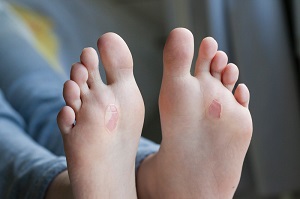
Once you start feeling rubbing occurring, or if you know it will start to occur, place tape on your feet. This will prevent blisters from occurring.
If you have blisters already, wash them with soap and water and place a bandage on them. Following that, you can put some tape over the bandage to keep it in place.
2. Climbing
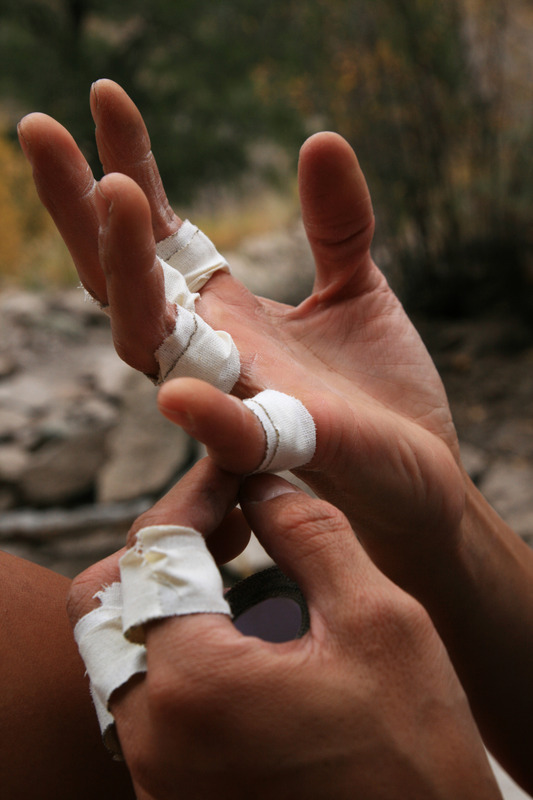
Tape your hands If you will be climbing and repelling during your hike or camping expedition.
This is important if you need the support or will be in rough conditions. If you are a beginner, you’ll notice how sensitive your hand may be after a climb or two.
If the rock face is rough and sharp, tape or climbing gloves (AD) will help save your hand from cuts and scratches as you climb and repel.
3. Support for Sprains or Injuries

To help support a sprain, you need to wrap tape or an elastic bandage around the ankle. This can be an effective tool to help you get through a hike on your own.
It helps to minimize any further damage and can help with swelling.
Using Athletic Tape for Rubbing and Blisters
Most hikers will have one or more experiences with their skin rubbing against their shoes. This can occur for different reasons, so finding out a preventative measure for your next hike will be helpful.
Until then, having some tape to prevent blisters will make your hike an enjoyable experience.
I have had several experiences with blisters, and sometimes it is unavoidable. When I wasn’t expecting to get a blister, I sometimes had a bandage available. I used the bandage to help stop further irritation. This works well as a temporary measure.
Regardless of how prepared you are, how good your shoes are, and how great your socks are, you may still get blisters.
Having some tape available can make all the difference in your overall hiking experience. Athletic tape can come in handy for blisters, support, and other uses where tape can help while camping (article).
Using Athletic Tape for Climbing

Climbers don’t always need to tape up their hands while climbing. A short rock face can be climbed with some chalk, some climbing shoes, and a rope and harness.
For those who are climbing in more difficult situations, they may require tape to prevent injuries to their skin and to help with support.
Using Athletic Tape for Support
If you need some extra support when hiking, taping up various areas that need it provides helpful support. Both athletic-type tapes and kinesiology tapes can help in giving you the needed support in different situations.
Here are a few ways you might need support when you go on a hike.
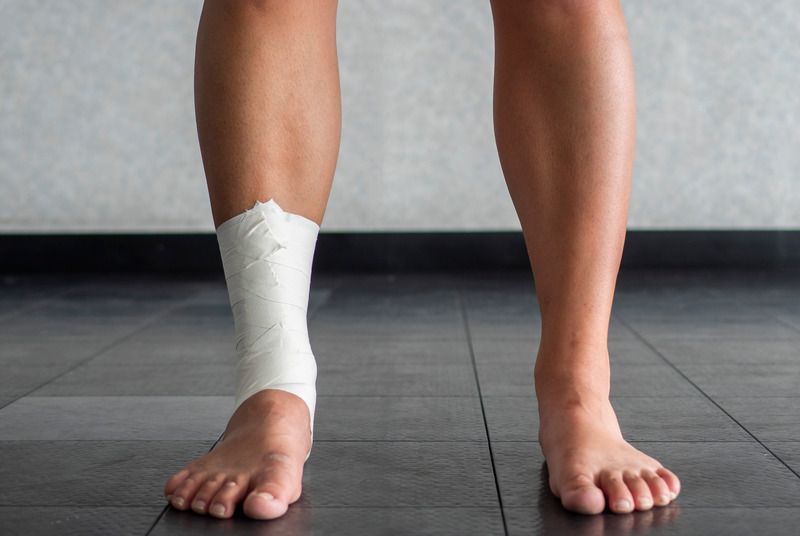
Ankle Support
When you have a muscle or joint that needs support, you can tape up the area to provide support and prevent injury or further injury.
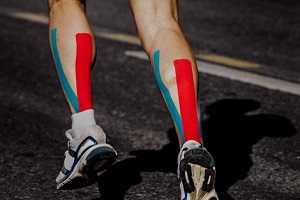
Muscle Support
If your muscles need some support, taping them can aid in the relief of pain and in providing support. It may reduce inflammation and relax the muscles as well.
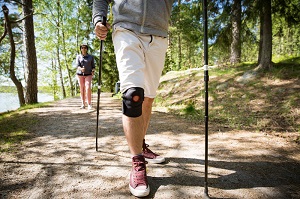
Knee Support
When your knees start to hurt during a hike, it may help to tape your knee for additional support.
Using hiking poles (article) in addition to tape can help relieve pressure and support your knee.
Plantar Fasciitis
Many people experience pain in their feet from plantar fasciitis. Using kinesiology tape can help.
Which Other Tapes Can I Use for Hiking?
You can likely use almost any type of tape when hiking to prevent blisters from occurring. Several types of tape can perform well under hiking conditions. Here’s a list of various tapes that you might consider using on your next hike.
| Product Image | Product Name / Price / Description | Primary Button |
|---|---|---|
|
||
|
||
|
||
|
||
|
||
|
||
|
QUALITIES: Very strong and rigid. Very good rub protection. Porous and water-resistant.
STICKINESS: Very sticky. 1-day use. Most uses Zinc Oxide. Pull off very slowly or wait a few days. People with sensitive skin can get rash.
BEST FOR: Blister and chaffing prevention, sprains, and support.
QUALITIES: Flexible, strong, breathable, and usually soft.
STICKINESS: Very sticky. Multi-day use. Pull off very slowly or wait 1-2 days.
BEST FOR: Support for muscles and joints. It may aid in blister and chafing prevention.
QUALITIES: Soft, padded, cotton, flexible, and usually latex-free.
STICKINESS: Average stickiness. 1-day use. Not irritating to most.
BEST FOR: Blisters and chafing prevention.
QUALITIES: Very strong and smooth. Good rub protection. All-day protection. Nonporous. CAUTION: This may cause skin irritation / allergic reaction in some individuals.
STICKINESS: Very stick but sensitive to moisture and perspiration. 1-day use. Pull off very slowly.
BEST FOR: Multi-purpose tape. It can help with blister and chafing prevention.
QUALITIES: Strong, water-resistant, soft, porous, and flexible.
STICKINESS: Good stickiness. 1-day use. Not irritating to most.
BEST FOR: Multi-purpose tape. It can help with blister and chafing prevention.
QUALITIES: Flexible, breathable, soft, reusable, and stretches very well.
STICKINESS: It will not stick to the skin but will stick to itself. Multi-day use. Nonirritating on skin.
BEST FOR: Support sprains and bandaging over the gauze. It moves when rubbed, so it works only in some situations.
QUALITIES: Very strong and rigid. Waterproof. Similar to athletic tape.
STICKINESS: Very sticky. 1-day use. Pull off very slowly.
BEST FOR: Good for keeping the dressing on the skin and covering areas that might get blisters.
There are probably many more types of tape, but these are the ones that most people might use during a hike. If you don’t have any tape available, a regular bandage can work for about a day as well.
Of all the tapes, I would most likely use moleskin for a day hike and a combination of moleskin and athletic tape for a week-long hike. I have used cohesive tape many times after giving blood, and they can work well with gauze but will likely bunch up if hiking.
I would use kinesiology tape for blister protection, especially in flexible areas of the foot. When I’ve used athletic tape and waterproof tape, they work well at protecting against rubbing. Just make sure the adhesive is strong, so fiction doesn’t pull it off.
Elastikon and duct tape may also be an option to bring along on your hike. Duct tape is versatile but may not be the most comfortable when hiking. I can imagine that it doesn’t breathe well. I would definitely take it off after hiking for the day. The adhesive material may not be best for the skin, so be cautious.
One more use for athletic tape is to cover other tapes or bandages. If your moleskin, gauze, or bandage starts coming off, just tape over it with athletic tape to secure it.
Do I Really Need Athletic Tape While Hiking?
When you are hiking, the last thing on your mind may be taping up your foot with athletic tape. You may not need athletic tape at all while you are hiking.
Although, the best method for having an enjoyable hike can be the preventative measures you take. Here are some of the preventative measures you can take to help yourself avoid injury and blisters without athletic tape.
Wear Comfortable Shoes
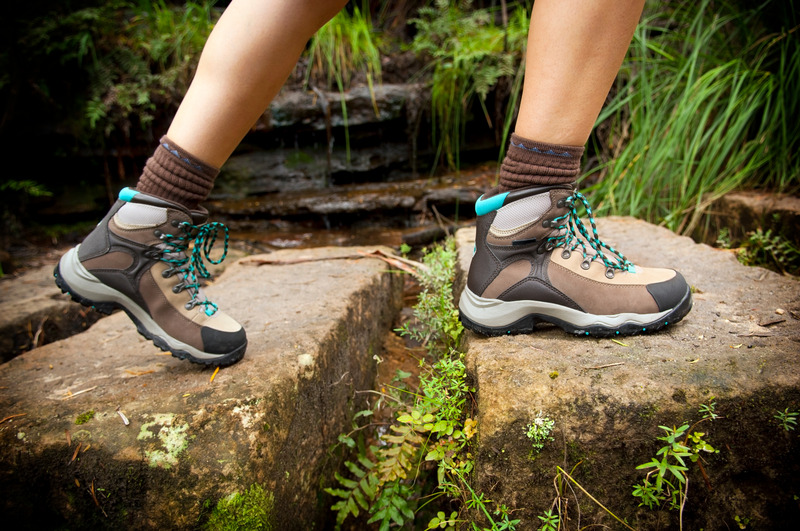
Some shoes are fine to hike in right out of the box. Yes, they may need a break-in period, but they won’t rub your feet while hiking. Other shoes will rub your feet, even after they have been broken in.
It’s very important to find the right pair of shoes that fit well on your foot while you are wearing your hiking socks.
You should practice wearing your backpack if you will be wearing one. After walking for 30 minutes to an hour, you should get a good idea if these are the right shoes for you.
Don’t forget to practice going uphill and downhill while wearing your shoes. This will help you find any areas that may cause rubbing.
Wear Two Pair of Socks
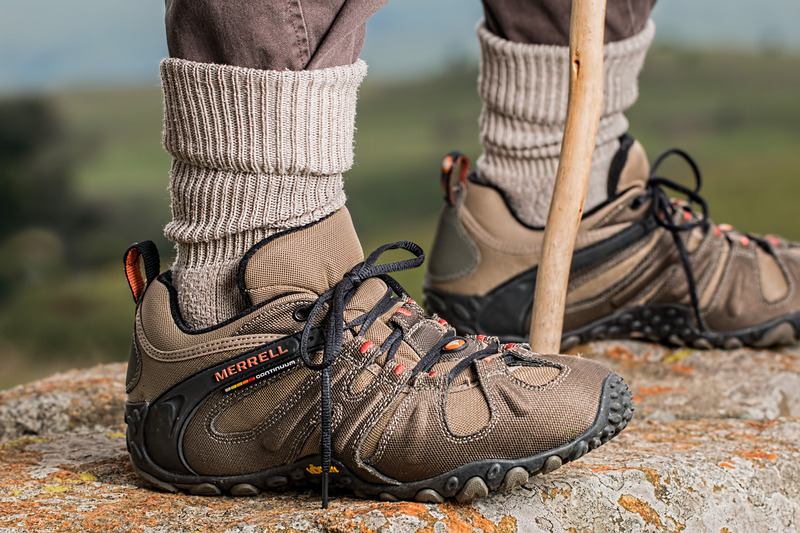
Wearing some good hiking socks (article) and sock liners can help prevent rubbing and blisters from ever occurring. If I hike longer than 1 or 2 hours, I need to wear two pairs of socks (hiking socks and liners) so my feet don’t rub.
Try using your socks with your hiking shoes before you go on a long hike. You can see how they work. Most hiking socks will perform well if they are paired with sock liners. If you still experience rubbing, you may need to find a way to get your foot snug but not tight.
Adding some more padding to the insole may help prevent a loose foot from shifting around and stop any rubbing from occurring. Adding a thicker sock has worked for me.
Sometimes, getting a new shoe may be the best option if you continue to have issues.
Using Anti Chaffing Balm
Some people use a balm on their feet to prevent socks from chaffing their skin. It can stop the friction between toes. Balms help prevent skin friction so that even with some rubbing, it’s fine.
The skin stays free of moisture, which can make the skin more prone to rubbing. It helps the skin stay soft and glide instead of rub. It’s kinda like chapstick but not greasy.
Applying it to the inside of your socks may also help with a bit more protection.
How Do I decide to use Tape or Not?
If you are going on a semi-strenuous hike for more than 2 hours, it’s important to have some athletic tape or other tape-like products. You may not need it, but having it will bring you peace of mind and help you when needed.
Here are some of the pros and cons of using athletic tape and other taping products. This list may help you decide if you should use tape or not.
Pros
- Prevents rubbing and blisters
- Supports muscles and joints
- Helps secure bandaged
- Usually breathable
- Can be either flexible or rigid
- Can help relieve some pain
Cons
- Can be hard to remove
- Can irritate skin
- May be harmful if masking pain, so you can keep hiking
- Your foot may get misaligned if used incorrectly
- May need to be changed daily
Conclusion
There are several good reasons to carry some athletic tape with you when you go on a hike. It helps prevent blisters and rubbing, can support joints and muscles, and helps secure bandages and sprains.
It’s light enough and small enough to carry with you in a backpack or in strips in a fanny pack or even your pocket. If you’re getting new shoes or hiking long distances, you can’t go wrong with carrying some athletic tape with you for your foot health.
Thanks for visiting Helpshoe.com

